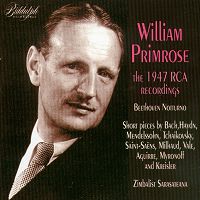|


Global Fascinations and Sophistications
William Primrose
Why is the viola player looked upon as the wallflower compared to the
violinist or cellist? In orchestral terms, the viola -- facing the conductor
or to his immediate right -- projects all those inner colours so essential
to composer and interpreter alike, which bring poetic eloquence and realization
to the whole performance. In chamber music, if the violist is sub-standard,
you pack up and go home.

Apart from Lionel Tertis, who we are told was a difficult man, but a
great player and protagonist for his instrument, no one did more to place
the viola firmly on the musical map than William Primrose. 'A New Sound
Sensation' read the hoardings for his Carnegie Hall appearance on 16 October
1946. In the 1950s, when Primrose performed Walton's Concerto at the Royal
Albert Hall, I was certainly aware of his tonal projection and platform
presence, his sonorous tones enriched by tapestries of autumnal shadings
reaching my balcony seat and beyond to the enormous dome above my head.
With this in mind, Biddulph, aided by Tully Potter's informative
liner notes, have risen to the challenge with a series of re-issues, the
latest devoted to 1947 recordings for RCA with the sensitive David Stimer
at the piano.
The famous Air from Bach's Third Suite takes on new nobility, giving
added strength and spiritual depth to the rising and dying phrases. The
Haydn Divertimento, next, is a Piatigorsky arrangement of two Baryton Trios
written for Prince Esterhazy, and the so-called 'Notturno' by Beethoven
is the composer's transcription of his Serenade for string trio plus some
of Primrose's 're-workings'. Thereafter we have a 'travelling
tour' of short pieces: Mendelssohn's May Breezes (one of the Songs
without Words), Tchaikovsky's famous Andante cantabile, Saint-Saëns'
The Swan, Kreisler's Schön Rosmarin & Liebesleid,
and some unusual items -- Aprie (still unpublished) by the soloist's
close friend Boris Myronoff, two Milhaud pieces -- Lema and Ipanema,
and Heifetz arrangements of Vale's Ao pé da fogueira and Aguirre's
Huella. The 'fun' item comes at the end: Sarasateana -- four
dance sequences by the eminent Sarasate entitled Tango [listen -- track 22, 1:52-2:37], Polo, Malaguena
and Zapateado, arranged by Efrem Zimbalist.
Continue >>
Copyright © 27 December 2000
Bill Newman, Edgware, UK
 CD INFORMATION - BIDDULPH BID 80147
PURCHASE THIS DISC FROM AMAZON
PURCHASE THIS DISC FROM CROTCHET
<< Music
& Vision home
Elly Ney >>
CD INFORMATION - BIDDULPH BID 80147
PURCHASE THIS DISC FROM AMAZON
PURCHASE THIS DISC FROM CROTCHET
<< Music
& Vision home
Elly Ney >>
 |
To listen to the aural illustrations in this review,
you may need to download RealNetworks' realplayer 8. |
|

